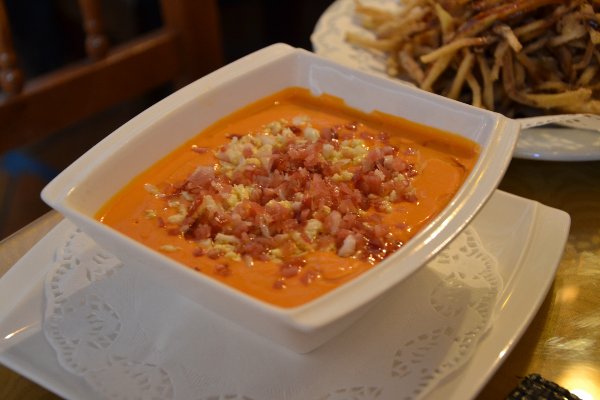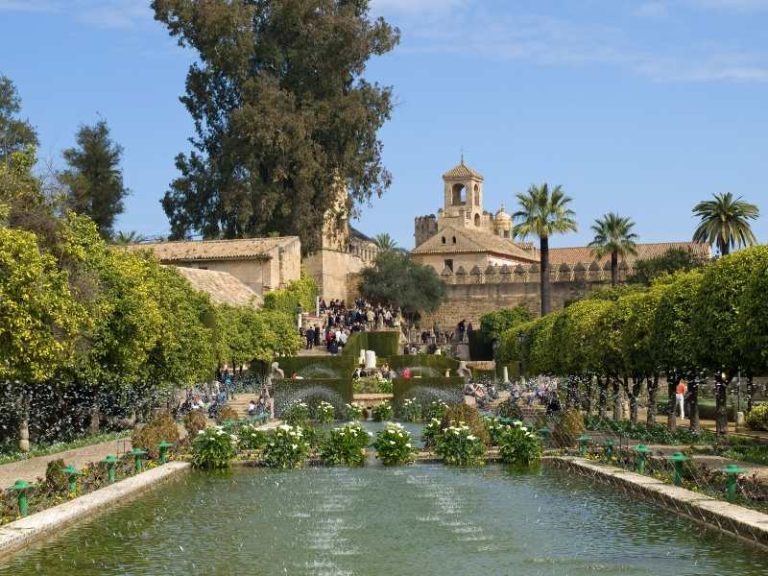Cordoba What to Eat
Local cuisine in Cordoba include unique food dishes that are rich and flavorful. This is a pleasant surprise to most travelers, because Cordoba mostly draws travelers interested in history and architecture.
Traditional food in Cordoba is influenced by the different civilizations that inhabited this part of Spain: Romans, Muslims, Christians, and Jews. All of them left their legacy in Cordoba.
What do people in Cordoba eat
Are you one of those travelers who enjoy trying local food? If so, there are some iconic dishes you don’t want to miss.
- “Flamenquín”: pork rolled, stuffed with ham, coated with egg and breadcrumbs and then deep-fried
- “Salmorejo”: cold tomato cream“Berenjenas fritas con miel”: fried eggplants with honey
- “Rabo de Toro”: oxtail stew
- “Pastel Cordobés” (Cordoba Cake): puff pastry sheet, “cabello de de angel” (pumpkin marmalade) sugar and cinnamon.
Do you want to discover more about the best foods to try in Cordoba and eat like a local?
Keep reading our post, but please don’t do it on an empty stomach or you will regret having visited this post 🙂
Cordoba What to Eat
What to Eat in Cordoba: Traditional Foods
Salmorejo
Without any doubt, salmorejo is a must-eat whilst you are in Cordoba. In a few words, salmorejo is a chilled soup consisting of tomato, olive oil and bread. We know what you are thinking, salmorejo is the ideal choice for vegetarians, or for those who stick to a healthy diet. This is almost a miracle in Spain since most dishes contain meat or are fried in liters of oil.
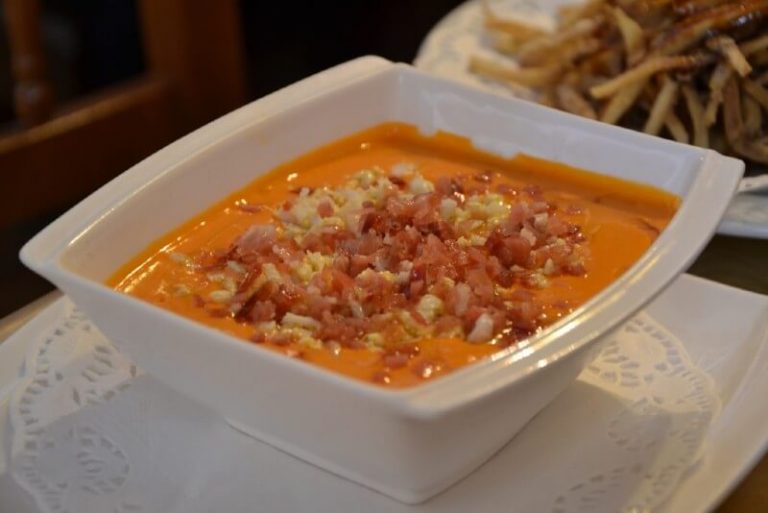
The ingredients to cook a genuine salmorejo are:
- Tomatoes
- Bread
- Garlic
- Salt
- Cumin
- Extra Virgin Olive oil
Salmorejo is usually accompanied by Spanish ham chunks, hard-boiled eggs, or green pepper.
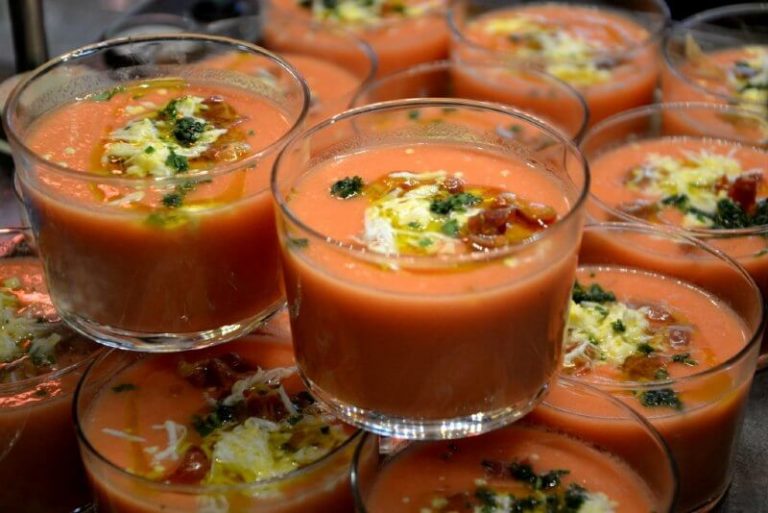
Please if you ever go to Andalusia (specially Cordoba) please try a dish called salmorejo, it's amazing 🙏🙏🙏
— Esther Galán 🍊 (@Esgalor) June 30, 2020
Andalusian food is amazing in general but my special recommendation: salmorejo
-Where to eat the best Salmorejo in Cordoba?
Salmorejo is one of the most iconic foods of Cordoba. You will find salmorejo in practically all the bars and restaurants in the city. But our favorite places in Cordoba to eat Salmorejo are:
-Taberna La Viuda (address: Calle San Basilio, 52)
-Taberna San Miguel Casa El Pisto (address: Plaza de San Miguel, 1)
-Puerta Sevilla (address: Calle Postrera, 51)
-La Salmoreteca (address: Mercado de la Victoria)
-Taberna Casa Salinas (address: Puerta de Almodovar s/n)
Flamenquín
This is one of the signature dishes in Cordoba. However, in recent years, flamenquín has crossed the borders of Cordoba and is increasingly popular in many Spanish cities.
Flamenquín consists of pork loin rolled and stuffed with ham, which is deep fried. Generally, this dish is accompanied by french fries and mayonnaise. Any bar or restaurant in Cordoba worthy of the name offers this traditional dish.
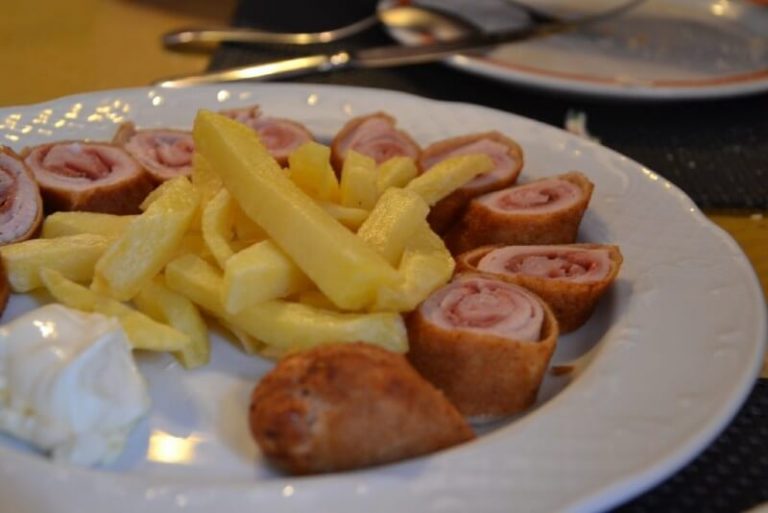
The name of this dish has a curious origin story that connects with the king of Spain himself. Flamenquín literally means “Little Flemish”. The crunchy golden coating of flamenquín resembled the blond hair of the Flemish assistants who came to Spain with the King Carlos I in the 16th century.
-Where to find the best Flamenquín in Cordoba?
If you want to try this local specialty in Cordoba, our recommendations are:
-Taberna La Viuda (address: Calle San Basilio, 52 ). They offer 2 types of flamenquín: the original one and Flamenquin with goat cheese. Both are delicious!! 😉
-Moriles 2 (address: Antonio Maura, 37)
-Campos de Toro (address: Calle Cespedes 6,)
-Restaurante Sociedad Plateros (address: María Auxiliadora, 25)
-Bodegas Campos (address: Calle Lineros, 32)
-Casa Rubio (address: Puerta de Almodovar, 5)
-Hermanos Bonillo (address: Calle Sagunto, 27). Ok, you will not find this bar in any tourist guide, but it is definitely one of our faves. It is outside of the city center (however only 10 min by taxi from the Mezquita-Cathedral), and it is very humble: there is no beautiful decoration nor stylish tablecloth, but, you will enjoy the best (and biggest) flamenquin in Cordoba there!!!
Everything is bigger in Hermanos Bonillo: the size of Flamenquin is about 30 cm (12 inches), and unless you are super-hungry, you cannot finish it alone. It comes with french fries and a bit of salad.
Trust us: if you want to eat home-made flamenquin as a local and surrounded by locals, this is your place!!! ATTENTION! As a 100% local place, they don’t speak a word of English 😀
Berenjenas con miel de caña (Fried Eggplant with cane honey)
Yeah, we know this combination sounds a bit strange, but trust us: you must try it!! Bit salty taste of eggplant tempura combines just perfectly with the sweetness of cane honey. Delicious!
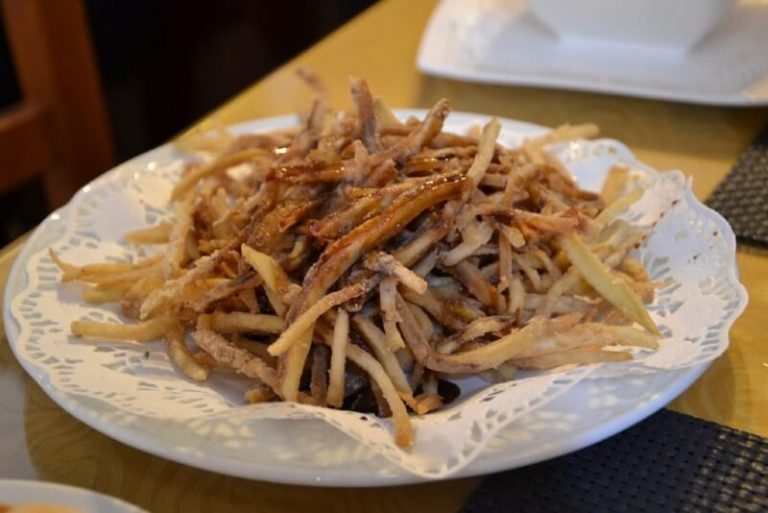
-Where to find fried eggplant with honey in Cordoba?
-Taberna La Viuda is definitely our favorite restaurant to eat fried eggplant with honey. Eggplant is cut into really thin strips, which melt in your mouth. Bet you can’t eat just one, as it´s just impossible to stop. Just the thought of having this local specialty makes our mouths water. 😀 Without a doubt, one of the top foods to try in Cordoba.
Rabo de Toro (Oxtail stew)
Here is another must-try in Cordoba! Oxtail stew is very appreciated by locals for its taste and creamy meat.
Before cooking, oxtail is really tough. For this reason, and following the traditional recipe, the oxtail is slow-cooked with different vegetables (carrots, leeks, garlic and onion), spices and red wine, resulting in rich, gelatinous sauces and tender meat.
The oxtail stew began to become popular in Cordoba in the 16th century. However, the current recipe is from the 19th century. At that time, the oxtail, along with other parts of the animal such as the stomach, ears, etc. was not very appreciated by the upper classes, who preferred the best cuts (more flavorful and richer in important nutrients). In this way, the oxtail stew became a traditional dish among the popular classes of Cordoba.
Despite its humble origins, nowadays you will find this dish in the best restaurants in Cordoba, Madrid or Seville.
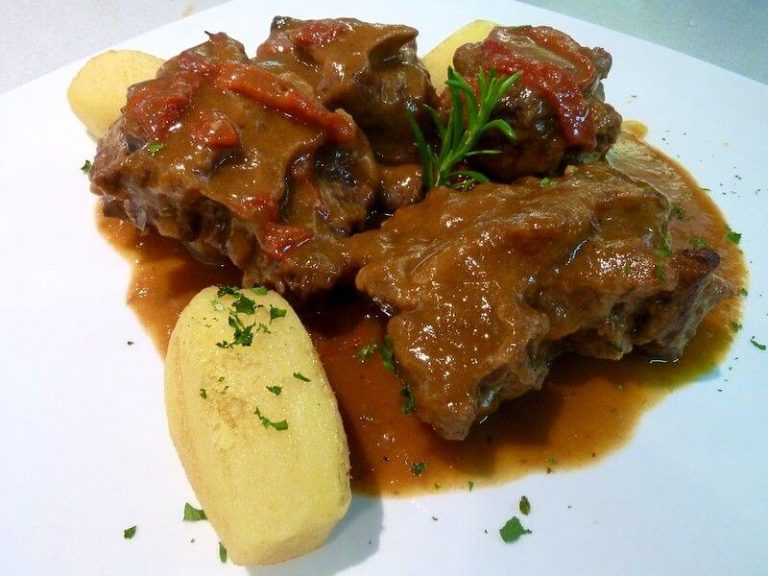
-Where to eat the best Rabo de Toro in Cordoba?
-Bodegas Campos (address: Lineros, 32)
-Mesón San Basilio (address: San Basilio, 19)
-Taberna El Capricho (address: Velazquez Bosco,)
-Restaurante Sociedad Plateros (address: María Auxiliadora, 25)
Jamón Ibérico (Iberian Ham)
If you travel to Spain, you must try the Iberian ham, probably the most precious food product of Spanish gastronomy.
In addition, Andalusia, and especially Cordoba, produces some of the best hams in all of Spain. Even the province of Cordoba can boast of having its own Denomination of Origin (Valle de Los Pedroches). The Denomination of Origin is an EU recognition that protects the hams produced in that region and certifies the quality and production process.
Are you going to miss the chance to try this local delicacy?
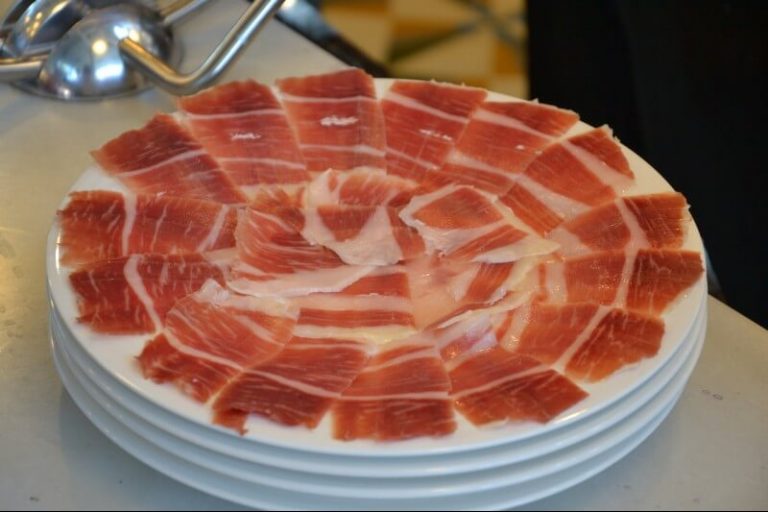
The hind legs of pork are cured for months in special places with certain lighting conditions and optimum moisture. The result, after 18 months, is an extremely deep, tasty, and nutty flavor, which is highly appreciated all around the world.
The Roll Royce of Spanish hams can be quickly identified by its intense red meat and flecks of intramuscular fat. This tasty meat is result of feeding pigs naturally.
Iberian ham should be served in paper-thin slices (including fat). When thinly sliced, the jamón almost melts on your tongue. Please, do not remove the fat from the ham. It is the best bite!
-Where to Buy Iberian Ham in Cordoba?
There are a lot of brands of Jamon Ibérico in Cordoba, however one of our favorites is “COVAP“.
They raise the pigs and produce their hams in the Valle de los Pedroches (protected as Denomination of Origin of Iberian Ham). A singular microclimate in the northern mountains of Cordoba and the natural feeding of pigs make their jamones taste really special!
You may arrange a visit to their facilities via: https://www.covap.es/contact/contacts/visit-covap/
-COVAP: (address: Calleja Barqueros, 2)
-COVAP (address: Mercado de la Victoria)
-Chacinas Manuel Castillo (address: Av. de Jesús Rescatado, 4)
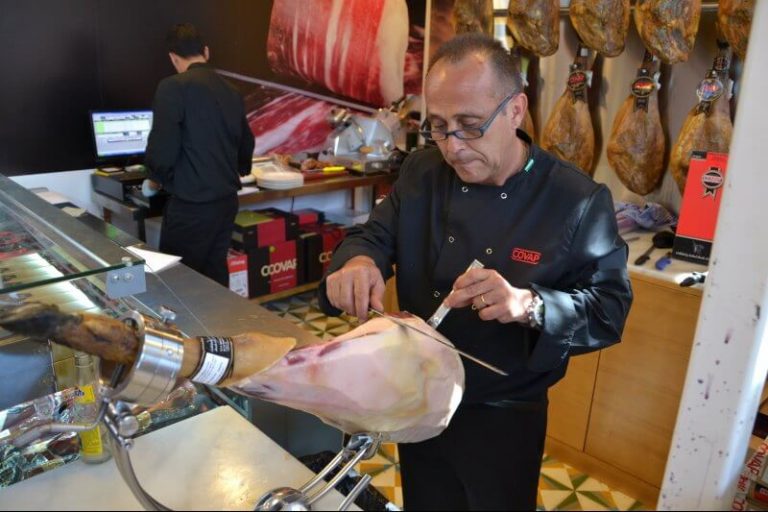
Gazpacho
Gazpacho is the successful sibling of “salmorejo“. Gazpacho has become well-known in many countries. You can even buy it in tetra pak cartons anywhere in the world.
But in Cordoba gazpacho gets a special taste; bars and restaurants use the best fresh ingredients and try to be creative to find the perfect gazpacho that amazes the city. As if this were not enough, Cordoba hot summer temperatures make you appreciate this vegetable delight so much more!
The main difference between gazpacho and salmorejo is the texture. Salmorejo is thicker and eaten with a spoon. Gazpacho is much more liquid and can be drunk even in a glass with ice.
The main ingredients of gazpacho are: tomato, bread, water, olive oil, garlic, salt and vinegar. Optionally, cucumber, pepper (green or red), onion or other vegetables can be added as well.
In any case, the secret of a wonderful gazpacho is to have it very cold!
-Where to try Gazpacho in Cordoba?
-Taberna El Pisto (address: Plaza de San Miguel, 1)
-La Viuda (address: Calle San Basilio, 52)
-Sociedad de Plateros María Auxiliadora (address: Calle María Auxiliadora, 25)
-Garum 2.1 (address: Calle San Fernando, 122)
-Casa Pepe de la Juderia (address: Calle Romero, 1)
Best Tapas in Cordoba
Most of the aforementioned dishes are usually eaten as a main course. However, a trip to Spain would not be complete without enjoying an authentic tapas experience!
First of all, we must distinguish among tapas, raciones and medias raciones.
Tapas are generally a small bite designed to be consumed individually.
On the contrary, it is very common among Spaniards to order several raciones or media raciones to share. This way they can try 3 or 4 different dishes and it is much more fun!
Raciones are designed to be shared between 3-4 people and medias raciones betweeen 2-3 people.
In a few words, the difference among tapas, raciones or medias raciones is just a matter of size.
Japuta (Fried Pomfret)
Although not on the coast, japuta is one of the most popular foods in Cordoba.
The traditional way of preparing japuta in Cordoba is marinated with pimentón (Spanish papikra), oregano, salt, garlic and vinegar. After 24 hours, the pieces of marinated fish are fried in abundant oil.
If you speak Spanish, the name of this fish may seem funny. In Spanish “hija de puta” (son of a bitch) sounds very similar to the word “japuta“.
There are many theories about the origin of the word japuta. According to historians and philologists, the word japuta comes from the Arabic šabbúṭa which was the word used by Muslims to name this fish.
-Where to eat japutas in Cordoba?
-Casa Rubio (address: Calle Puerta de Almodovar, 5)
-Bar Miguelito (address: Calle Acera Pintada, 8)
-Los Berengueles (address: Calle Conde de Torres Cabrera, 7)
Croquetas (croquettes)
Croquetas are one of the traditional foods you must try in Cordoba. However, it is very important to choose the right place, since in typical tourist bars they usually offer non-homemade corquettes, which is a real shame.
In Spain croquetas don’t contain potatoes as in many other european countries: actually Spanish croquetas are made with white sauce (bechamel in Spanish) and different fillings: Iberian ham, spinach, chicken, cod, mushrooms…
Croquetas are deep-fried and have to be crispy outside and very, very soft inside.
-Where to eat croquetas in Cordoba?
-Taberna La Montillana: (address: Calle San Álvaro, 5)
-Casa Pepe La Judería: (address: Calle Romero, 1)
-La Viuda: (address: Calle San Basilio, 52 )
-La Taberna de Almodovar (address: Calle Benito Pérez Galdós, 1)
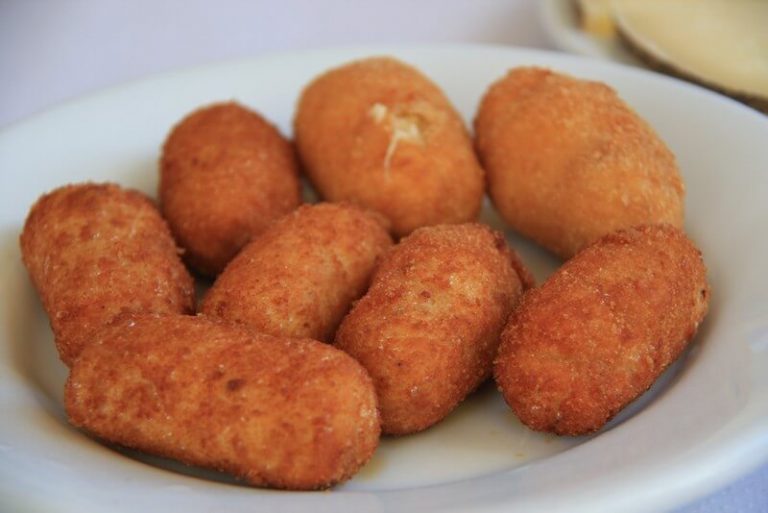
Tortilla de Patatas (Spanish Omelet)
“Tortilla de Patatas” is one of the most iconic mout-watering foods from Spain. Spaniards absolutely love tortilla and eat it at all hours, even for breakfast.
The ingredients to cook a genuine Spanish tortilla are simple: eggs and potatoes fried in olive oil (onions and peppers can be added too).
Chronicles say that this recipe was born in Navarre (North Spain) in the 19th century, during the Carlist Wars (1833 to 1876), which was the last major civil war for the throne in Europe; the general of the Army, Tomas Zumalacárregui, created the Spanish tortilla as an easy, fast, and nutritious dish to feed the Carlist Army. From North Spain, tortilla became popular across the country.
There are many ways to cook the Spanish omelet. However, lately it is very common to find omelets in which the eggs do not curdle at all, what makes tortilla very juicy and soft. If you prefer, you can ask the waiter for a fully cooked tortilla. It is a matter of taste. But, how to say that in Spanish? Do not panic, it is easy:
-Fully cooked tortilla: “Por favor, me gustaría una tortilla bien cuajada”
-Under-cooked tortilla: “Por favor, me gustaría una tortilla poco cuajada”
-Where to try the best Spanish omelet in Cordoba?
If you decide to try the Spanish omelet, these are our favorite bars and restaurants where you will find a genuine Spanish tortilla:
-Bar Casa Pepa de la Judería (Address: Calle Romero, 1)
-Taberna el Poema (Address: Calle Alonso de Burgos, 2)
-Con Tres Huevos (Address: Calle Poeta Juan Ramón Jiménez, 1)
Bar Santos is a tiny bar recommended by many travel guides to eat omelette. However, it is not our favorite choice. We find it kinda overrated (Address: Calle Magistral González Francés, 3).
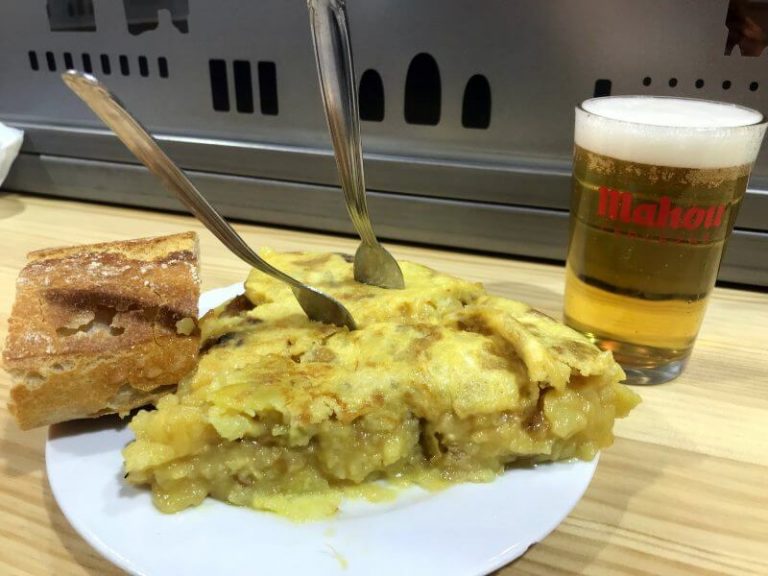
Boquerones en Vinagre (anchovies marinated in vinegar)
The origin of this dish is lost in time. We must not forget that vinegar, like salt, has traditionally been one of the most widely used preservatives in Spain.
Once clean, fresh anchovies are marinated in vinegar for 5 – 7 hours. Afterwards, abundant olive oil, garlic and parsley are added.
In our humble opinion, boquerones en vinagre are one of the most delicious tapas in Spain!
-Where to eat boquerones en vinagre
Many bars and restaurants offer boquerones en vinagre, but some of our favorites are:
-El Rincón de las Beatillas (address: Plaza de las Beatillas, 1)
-Taberna El Poema (address: Calle Alonso de Burgos, 2)
-Bar Natali (address: Calle Dr. Barraquer, 2)
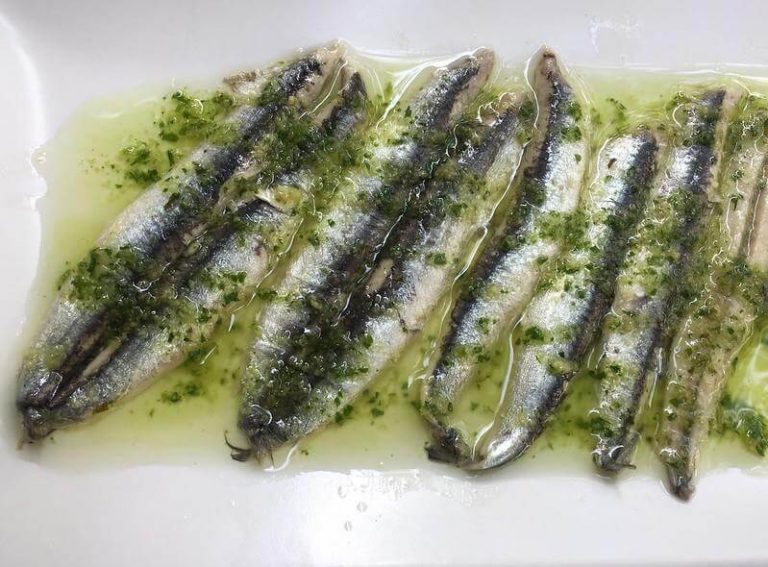
Pinchos Morunos (Moorish skewers)
Pinchos morunos is not a dish originally from Cordoba. If you travel through Spain you can enjoy this dish in many other cities such as Seville, Malaga or even Madrid. However, the pinchos morunos are tremendously popular in Cordoba.
The meat (usually chicken or pork) is diced and marinated with paprika and garlic. After that, the meat cubes are inserted on skewers and grilled.
There is a small bar called Juanito Mohamed where they also offer delicious lamb skewers. Probably the best pinchos morunos in town!
-Where to eat pinchos morunos in Cordoba
-Taberna Rafalete (address: Calle Diario de Córdoba, 5)
-Bar Los Romerillos (address: Calle Acera del Arrecife, 6)
-Bar Juanito Mohamed (address: Calle Marruecos, 10)
Ensaladilla Rusa (Russian Potato Salad)
Spanish version of the popular Olivier Salad, which is originally from Russia.
Ensaladilla Rusa is very popular in Cordoba, especially in the summer months as it is served cold.
Unlike the classy version of the potato salad invented by the Chef Lucien Olivier in Russia, in Spain ensaladilla rusa includes potatoes, peas, carrots, hard boiled egg, tuna, mayonnaise and even “piquillo” peppers.
Usually, locals accompany ensaladilla rusa with crunchy breadsticks and crackers.
-Where to eat Ensaladilla Rusa in Cordoba
-Casa Tollín (address: Calle Málaga 1)
-El Gran Bar (address: Plaza de las Tendillas)
-Taberna San Cristóbal (address: Calle Rodolfo Gil, 4)
-El Barón (address: Plaza de Abades, 4)
-Los Berengueles (Conde de Torres Cabrera, 7)
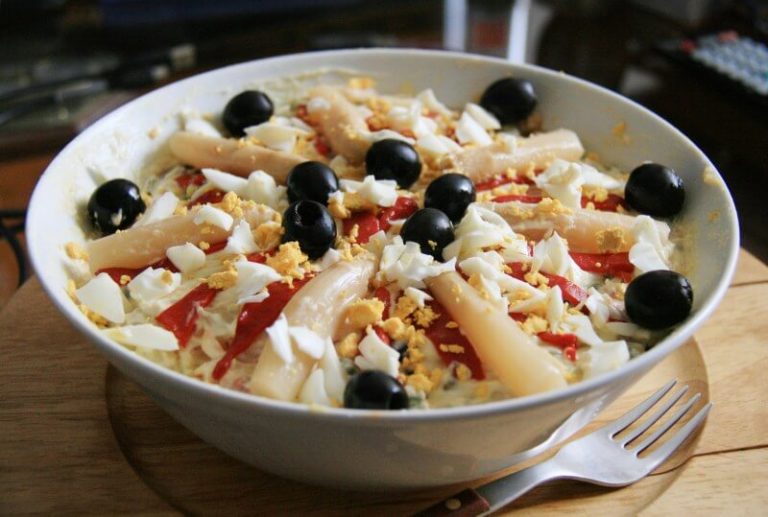
Cogollos con ajo (baby gem lettuce with garlic)
It is undoubtedly one of the healthiest and freshest starters that you will enjoy in Cordoba.
Basically, this dish consists of baby gem lettuce, fried garlic, olive oil and vinegar. Simple but delicious!
-Where to eat cogollos con ajo
-Bar Rafalete (address: Calle Periodista José Luis de Córdoba, 2)
-Taberna San Cristoba (address: Calle Rodrigo Gil, 4)
-Restaurante Sociedad Plateros María Auxiliadora (address: Calle María Auxiliadora, 25)
Caracoles (Snails)
With the advent of the first rays of spring sunshine the city fills with large snail stands. Yes, just like in some parts of France, in Andalusia snails are a highly appreciated product! These stands are greatly frequented by locals late in the evening, when thousands of “cordobeses” come to enjoy this local specialty and relax with friends and family.
As tradition marks, snails are served in small glasses filled with a mint water-broth and accompanied by a nice cold beer. Generally, these snail stands have terrace where customers can sit. You can also order snails for takeout.
If you have never eaten snails and want to try them, locals have two methods of eating them: you can suck them straight out of the shell, or you can use a toothpick to pull them out.
what to eat for breakfast in Cordoba
We highly recommend you try an authentic Andalusian breakfast during your stay in Cordoba. Generally, on a day-to-day basis, locals do not spend much time having breakfast; a quick cup of coffee, a piece of toast, that’s it.
However, on holidays they do respect the ritual of a genuine Andalusian breakfast.
What is an Andalusian breakfast?
Overall, we can distinguish two types of Andalusian breakfast.
-Pan con tomate y jamón: Toast with olive oil, crushed tomato, and slices or chunks of Iberian ham. Local people usually accompany this breakfast with a “café con leche” (coffee served with equal parts espresso and milk) or “zumo de naranja” (orange juice). There is not much variety of bread in Andalusia. However, one of the most popular breads is called “mollete“, which is a traditional white flatbread.
-Churros: It is a deep-fried dough traditionally eaten during fall and winter when temperatures drop. Perhaps it is their simplicity or their loop shape what make them so popular. In any case, they are yummy. Churros are ridged due to having been piped from a “churrera”, a syringe with a star-shaped nozzle. There is also another version of churros very popular in Cordoba; “porras”, also called “jeringos”, which are longer and thicker than churros. We absolutely love both of them.
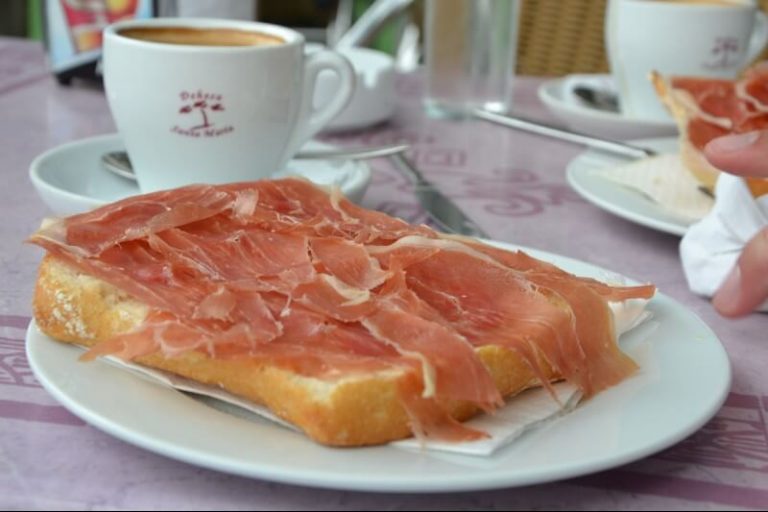
-Where to eat an Andalusian Breakfast?
-Bar Marta (address: Jose Cruz Conde, 32) offers delicious typically Andalusian breakfasts. Probably the best “jeringos” in Cordoba! The only problem is that the bar is always crowded with locals.
-Cafeteria Roldan (address: intersection between Gondomar Street and Paseo de la Victoria) is also a good place to have “molletes con jamón”.
-Cafetería Don Pepe (address: Diego de León, 6) and Bar Natali (address: Calle Dr. Barraquer, 2) are also two great places to have tomato-rubbed toast with Spanish ham.
What to drink in Cordoba
Traditionally, the most consumed drink has always been the wine produced in the province of Cordoba. However, in recent decades, especially since the rise of craft brewing, beer consumption has exploded, overtaking even wine as the most popular drink.
However, there are many classic drinks that go away beyond beer and wine. Let’s take a look!
Tinto de Verano
It is a drink made with soda, red wine and ice that is very popular during summer months, when people have to deal with extreme heat. Try Tinto de Verano and you will feel practically cordobes yourself.
You will have no problem finding this drink in any bar or restaurant in Cordoba.
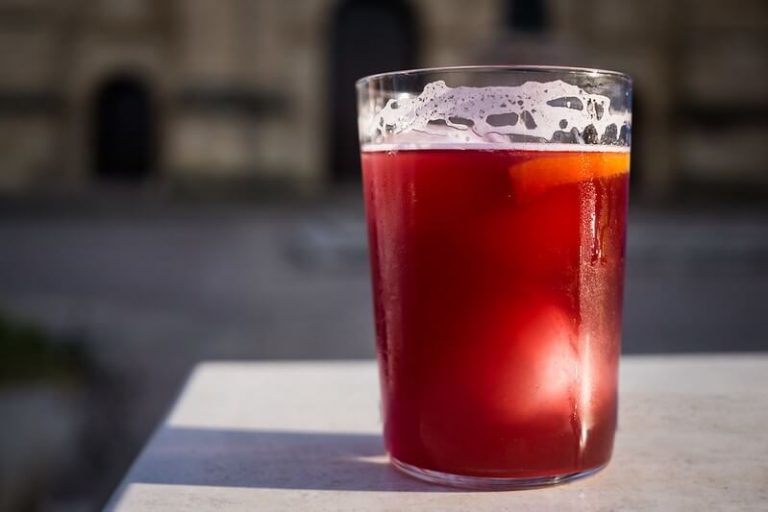
Fiti-Fiti
Yes, that is how we pronounce “fifty-fifty” with Andalusian accent. It is called like this because it combines in 2 equal parts two of the most famous Andalusian wines: Pedro Ximenez sweet wine and Fino (dry white wine from the mountains of Cordoba).
It is possible to adapt the combination to your taste, though: more sweet or, on the contrary, more dry.
Without a doubt, this is the most special Cordoba drink that only real locals know!
Try fiti-fiti in a tiny bar called La Uva on Juderia Street, just few minutes away from the Mosque-Cathedral of Cordoba: this bar was opened 90 years ago and until today preserves the secret of the best “fiti-fiti” of Cordoba!
Despite its excellent fiti-fiti, tapas could be much better than they are now. This is the only downside.
Montilla-Moriles Wine
In the south of the province of Cordoba is produced an excellent wine commercialized under the name Montilla-Moriles. The conditions of soil, low rainfall, and the average annual amount of sunhours, over 300 days a year, favour the cultivation of vines.
Montilla Moriles wines are known for having particularly high alcohol by volume (about 15-20 degrees), high sugar content due to extreme weather conditions (cold winters and sweltering summers), and an intense aroma. We highly recommend trying Pedro Ximenez, which is a delicious natural sweet wine.
One of our favorite places to drink wine in Cordoba is Bodega Guzmán, a traditional, no frills tapas bar, in the heart of the historic Jewish Quarter.
This bar is not much frequented by tourists. Quite the opposite, you will find old men sitting around, friends gathering, etc.
-Bodega Guzmán (address Calle Judíos 7)
Most interesting wine, my first from DO Montilla Moriles, Andalucía. 100% #pedroximenez sun-dried grapes fermented, aged 28 years in old American oak. Deep dark brown, prune, raisin juice, carob aromas; mouth coating, similar flavors plus a balsamic caramel lift. #dessert pic.twitter.com/uzcYjFbZgf
— savortheharvest (@savortheharvest) January 4, 2021
Sangria: tourist trap or traditional drink?
This drink is extremely popular in Spain and Portugal. Its origin dates back to the first decades of the 19th century, and its name (sangría) comes from the Spanish word “sangre” (blood), due to the red color of this drink.
Nowadays sangria is one of the most demanded drinks by tourists in Spain, so practically all bars and restaurants offer it.
Despite the fact that it is a very popular drink, locals barely drink it in bars: sangria is demanded by tourists only, and prepared for tourists only, so some bars would use poor quality wine for sangria preparation, and many locals know it! That´s why we prefer to make sangria at home.
Does this mean that it is impossible to enjoy authentic sangria in a bar? Not at all, but you should choose non-touristy bars and reputed restaurants (visit: where to eat in Cordoba).
Personally we recommend you rather order “tinto de verano” instead of sangría in the bars. It tastes very similar, but is lighter in alcohol and without fruites, and definitely much more local!
In case you want to prepare a genuine Spanish Sangria at home, these are the basic ingredients:
- Red wine
- Sugar
- Orange juice and lemon juice
- Chopped fruit (peach, apple, pear …)
- Cinnamon
- Orange soda
- Vermouth and brandy spirits.
In some parts of Spain, they use white wine instead of red wine. Or for example, in Asturias (North Spain) they prefer cider instead of wine.
Another important factor to achieve a delicious sangria is to marinate the fruit in wine for at least 24 hours (the longer the better).
The popularity of sangria has spread beyond the Iberian Peninsula. In the early 20th century Spanish emigrants took the beverage to Argentina and other parts of South America where it became very popular too
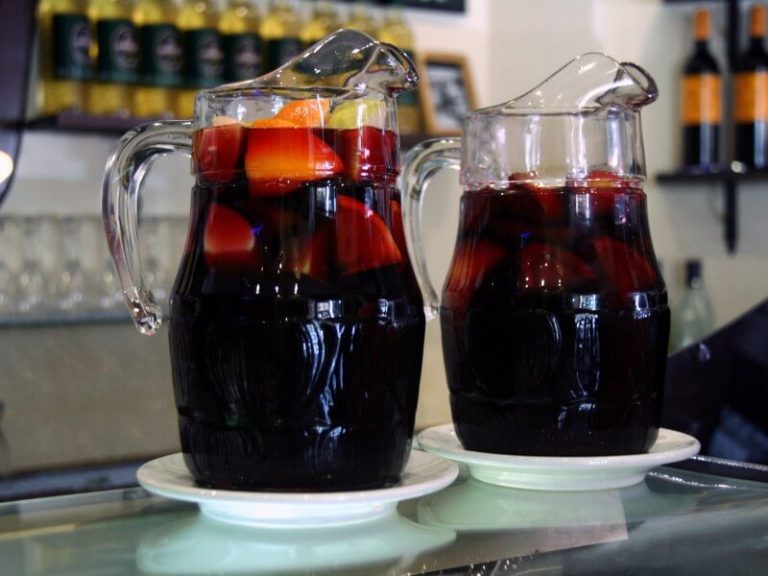
Traditional Sweets in Cordoba
The Arab heritage is quite evident in the Andalusian confectionery; almonds, honey, cinnamon are very common ingredients in traditional sweets in Andalusia.
– “Pastel Cordobes” (Cordoba Cake): It is undoubtedly the most popular cake in Cordoba. Main ingredients: puff pastry sheet, “cabello de de angel” (pumpkin marmalade), sugar, and cinnamon.
– “Manolete”: The same as the Pastel Cordobes but smaller.
Depending on the season, you can find other traditional sweets.
-During Holy Week, you must try “buñuelos” or “torrijas“
–Huesos de Santo (almond marzipan rolls filled with egg yolk cream) are made for All Saints’ Day on November 1
-On January 6 (Epiphany) all the pastry shops in the city sell the traditional Roscón de Reyes (brioche-like sweet bread filled with whipped cream).
As tradition marks, a kind figurine and a bean are hidden within the Roscón de Reyes; the person who finds the figurine will be lucky, however, who finds the bean must pay for the Roscón.
Ver esta publicación en Instagram
Una publicación compartida de Lingwei&Mireia | FOODIE SEEKER 😋 (@foodie_seeker)
-Where to try traditional sweets in Cordoba
If you want to try one of these delicious and traditional sweets, we recommend:
-Roldan Bakery (address: intersection between Gondomar Street and Paseo de la Victoria)
-Salazar Patisserie (address: Avenida Ronda de los Tejares, 3)
-La Sultana (address: Cronista Salcedo Hierro, 6 and Avenida Jesús Rescatado, 22).


